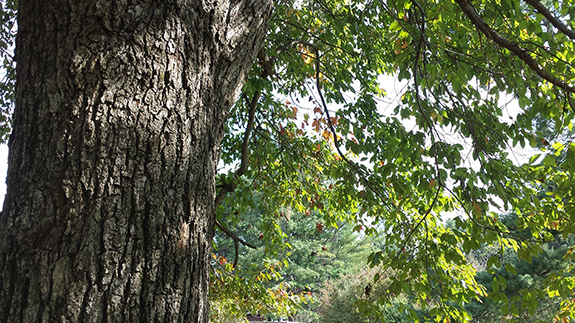
Black gum trees provide fall color interest in any landscape. Mature trees can grow to a height of 50 feet or more with a lovely drooping habit. Photo of specimen on the grounds of the UT Extension Central Region Office in Nashville, Tenn. by P. McDaniels.
|
|
Looking for incredible fall color? Our native black gum tree, sometimes called black tupelo, (Nyssa sylvatica) is a handsome tree that’s hard to beat when it comes to spectacular autumn foliage. Inconspicuous spring blooms and glossy, green foliage hardly make this tree stand out in the garden the rest of the year, but when autumn comes, Nyssa sylvatica becomes a real showstopper. With mosaic foliage ranging from bright yellow and orange to deep red and even purple all on one tree, Michael Dirr notes the black gum as “one of our best, most consistent, and most beautiful trees in the fall” in his Manual of Woody Landscape Plants.
This native tree has a wide range, found as far south as Texas and Florida, north into Maine, and west to Michigan. The black gum favors wet conditions and may be found growing alongside cypress and willows. Although black gums prefer moist but well-drained slightly acidic soil, they can handle drier conditions common in most landscapes. Nyssa sylvatica is dioecious, which means that male and female flowers are found on entirely different plants. Small, yellow-green blooms on the female trees ripen into attractive dark fruits in the fall. The blackish blue drupes are enjoyed by many species of birds and other animals, which makes a female tree a desirable addition to the wildlife garden.
Nyssa sylvatica has an attractive habit that would make a fine addition in many landscapes. The black gum has a narrowly pyramidal shape in youth that becomes more horizontal with gently drooping branches as it ages. This tree typically doesn’t grow more than 50 feet tall with a span of greater than 30 feet, although the national champion in Louisiana is nearly 150 feet tall. It would take some time for a newly planted black gum to match the champion, as Nyssa sylvatica is a notoriously slow grower in many landscape settings. Dirr notes the growth rate as 12-15 inches over 10 to 15 years.
Many wonderful selections of black gum have been introduced in recent years that broaden the tree’s use in the landscape:
‘Wildfire’ - new growth emerges with a reddish color that persists into summer.
‘Zydeco Twist’: slightly contorted, zigzag branches add winter interest and are ideal for landscape nighttime up-lighting.
‘Green Gable’ - notably glossy foliage, beautiful fall color and superior pyramidal form due to its dominate leader.
‘Jolly’ – glossy green leaves are variegated with white and don't burn in full sun.
Tupelo Tower™ - narrow form growing just 10-15 feet wide.
‘Sheri's Cloud’ –creamy white and green variegated foliage turns pink and red in autumn.
‘Autumn Cascade’ - a strong weeping habit with an irregular habit. If staked, grows to 10' tall x 6' wide in 10 years. Striking form adds winter interest and is ideal for landscape nighttime up-lighting.
'Red Vain' - a weeping form that is spreading and allegedly more pendulous than ‘Autumn Cascade’.
With all these benefits, why don’t we see more Nyssa sylvatica in the landscape? Historically, black gums have been considered difficult to transplant due to their deep taproot. To overcome this difficulty, consider starting with a smaller caliper tree, and allow your black gum to mature in the landscape.
If there is (or was) a Bradford pear in your landscape that you were thinking about replacing, consider Nyssa sylvatica as a strong and handsome alternative for attractive habit, glossy foliage, and stunning fall foliage. You can find an established stand of black gums growing on the Knoxville campus of the UT Gardens between Neyland Drive and the HGTV beds, and be sure to visit this month to see the gorgeous mosaic fall color.
Amanda Plante Spangler is a graduate of the UT Department of Plant Sciences and a former student of Dr. Sue Hamilton, director of the UT Gardens. She now works as a horticulturist at the Knoxville Botanical Garden & Arboretum and continues to volunteer at the UT Gardens, Knoxville.
The UT Gardens includes plant collections located in Knoxville, Jackson and Crossville. Designated as the official botanical garden for the State of Tennessee, the collections are part of the UT Institute of Agriculture. The Gardens’ mission is to foster appreciation, education and stewardship of plants through garden displays, educational programs and research trials. The Gardens are open during all seasons and free to the public. For more information, visit the Gardens website at utgardens.tennessee.edu.

